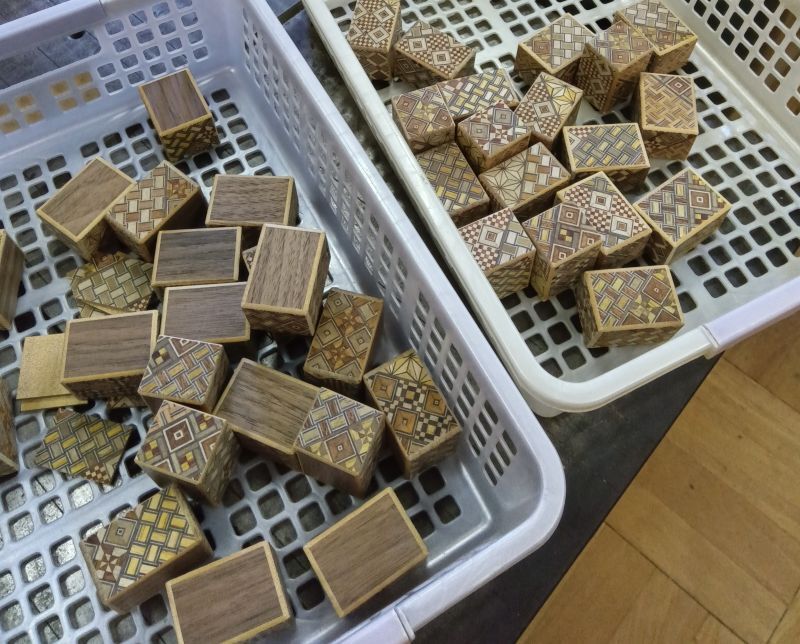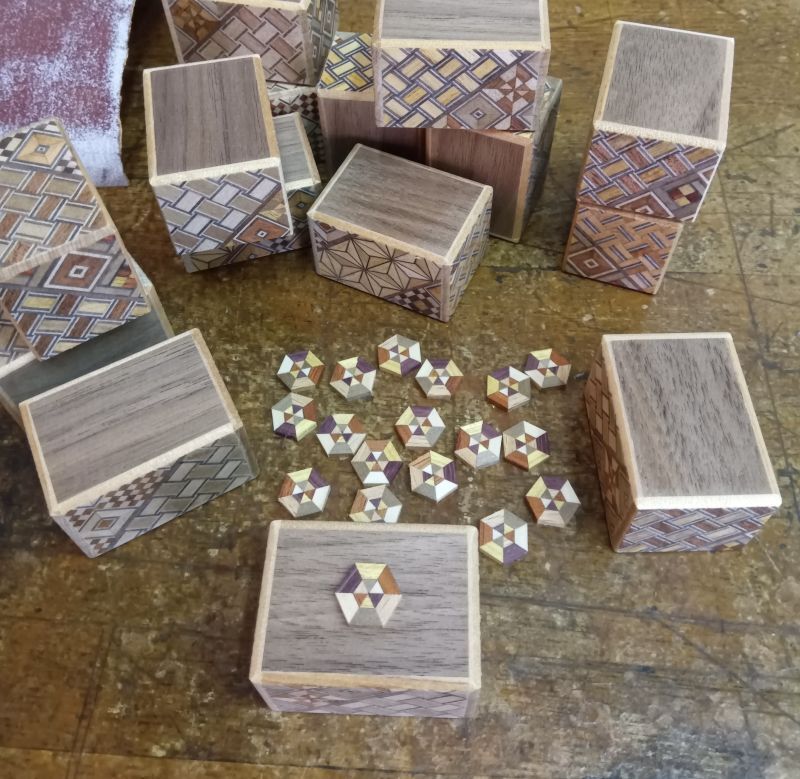Solid hexagon yosegi
Today is Monday, and it's another very hot day! Many companies are starting work today after the long Obon holiday, which lasted until yesterday. It doesn't really affect me 🤣
Tiny Mame puzzle box is almost finished, as shown in the photo. All the sides panels have been attached, and after rounding the corners of the box, I smooth the surface with sandpaper. Next, I'll move on to the finish coating process, but before that, I'm making two types of 18-step Mame puzzle boxes this time. One of them will have solid hexagonal Yosegi attached.
Yes, I always attach the solid hexagonal yosegi right before the finish coating process. It's glued on using wood glue, just like the other processes, but I have to be very careful to prevent the glue from seeping out. If the glue seeps out and gets on the walnut wood top panel, it’s difficult to remove, as it can seep into the wood grain and is hard to clean off. If any glue remains on the walnut panel, it will turn white and appear as a stain after the finish coating is applied, which looks very unattractive. However, since the hexagonal yosegi is pressed to slide the lid when operating the puzzle mechanism, it must be firmly attached. So, I carefully determine the right amount of glue to ensure the yosegi is securely attached without any excess.
When attaching the hexagonal yosegi, I don't use any rulers or templates. I place this yosegi in the center purely by eye, where I believe it looks just right. In many cases, using a ruler can actually make it appear off-center. Since it's the customer who judges if something looks off, if it looks centered to me, it will likely look centered to them as well. In other words, sometimes the human eye is more accurate than a ruler. This approach is also used in other process of making the Japanese puzzle box. We might call it the craftsman's eye judgment 😄
Tiny Mame puzzle box is almost finished, as shown in the photo. All the sides panels have been attached, and after rounding the corners of the box, I smooth the surface with sandpaper. Next, I'll move on to the finish coating process, but before that, I'm making two types of 18-step Mame puzzle boxes this time. One of them will have solid hexagonal Yosegi attached.
Yes, I always attach the solid hexagonal yosegi right before the finish coating process. It's glued on using wood glue, just like the other processes, but I have to be very careful to prevent the glue from seeping out. If the glue seeps out and gets on the walnut wood top panel, it’s difficult to remove, as it can seep into the wood grain and is hard to clean off. If any glue remains on the walnut panel, it will turn white and appear as a stain after the finish coating is applied, which looks very unattractive. However, since the hexagonal yosegi is pressed to slide the lid when operating the puzzle mechanism, it must be firmly attached. So, I carefully determine the right amount of glue to ensure the yosegi is securely attached without any excess.
When attaching the hexagonal yosegi, I don't use any rulers or templates. I place this yosegi in the center purely by eye, where I believe it looks just right. In many cases, using a ruler can actually make it appear off-center. Since it's the customer who judges if something looks off, if it looks centered to me, it will likely look centered to them as well. In other words, sometimes the human eye is more accurate than a ruler. This approach is also used in other process of making the Japanese puzzle box. We might call it the craftsman's eye judgment 😄

